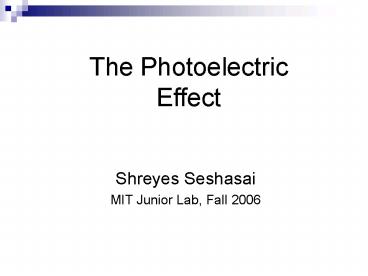The Photoelectric Effect - PowerPoint PPT Presentation
1 / 14
Title:
The Photoelectric Effect
Description:
Photoelectric Effect demonstrates the wave-particle duality of light. Observed by Heinrich Hertz in 1887, when he noticed light from sparks would induce a current ... – PowerPoint PPT presentation
Number of Views:839
Avg rating:3.0/5.0
Title: The Photoelectric Effect
1
The Photoelectric Effect
Shreyes Seshasai MIT Junior Lab, Fall 2006
2
Talk Outline
- Introduction
- Theory
- Experiment Set-up and Data Collection
- Results and Error Analysis
- Conclusion
3
Introduction
- Photoelectric Effect demonstrates the
wave-particle duality of light - Observed by Heinrich Hertz in 1887, when he
noticed light from sparks would induce a current - Einstein proposed the idea of light quanta in
1905, with light consisting of discrete quanta of
energy h?
4
The Theory behind the Effect
- Light consists of quanta of energy, E h?
- Metals have a specific work function, ?,
corresponding to the minimum amount of energy
required to excite an electron - If the energy of incident photons is greater than
?, electrons will be emitted with the difference
in energy - This can be summarized by
- K h? - ?
- There is a one-to-one interaction between photons
and electrons, so the intensity of the light
doesnt affect energy of the emitted electron
5
Setting up the Experiment
- Mercury Lamp emits a
- specific spectrum
- Filters are
- 360.0 2.0 nm
- 404.7 2.0 nm
- 435.8 2.0 nm
- 546.1 2.0 nm
- 577.0 2.0 nm
Source The Photoelectric Effect, MIT 8.13 Lab
Guide. http//web.mit.edu/8.13/www/JLExperiments/J
LExp005.pdf
6
Data Collection
7
Data Collection (cont)
Note currents normalized to Dark Purple filter
8
Data Collection (cont)
Note currents normalized to Dark Purple filter
9
Analyzing the Data
- Stoppage voltage determined in two ways
- (a) by finding a linear approximation for the
I vs V curve and determining when I 0 - (b) by estimating where the current begins to
rise
10
Calculating h and ?
- Ee h? ?
- Ee energy of the electron
- h Plancks constant
- ? the frequency of the incident photon
- ? the work function of the metal
11
Results
12
Calculations
- Solving for Plancks constant, h and the work
function ? - (a) linear fit V -0.9191 2.119310-15 (?)
- h 2.119310-15(1.610-19)
- 3.4 2 10-34 J-s
- ? 0.92 0.5 V
- Taking into account the contact potential
difference between the electrodes, ?A - ?C,, ?
.92 3.4 4.3 0.5 V - (b) linear fit V -1.3566 3.175510-15 (?)
- h 3.175510-15(1.610-19)
- 5.1 2 10-34 J-s
- ? 1.36 0.5 V
- Corrected value ? 1.36 3.4 4.8 0.5 V
13
Error Analysis
- Possible sources of error include
- Systematic error with the machinery/filters
- Induced current from external sources (very
sensitive to wire movement) - For the work function, gases in the photocell
interact with the cathode surface
14
Conclusion
- Results for Planks constant are on the same
order as the accepted value - 3.410-34 J-s and 5.110-34 J-s
- (Accepted value h 6.62610-34 J-s)
- Results for the work function
- ? 4.3 0.5 V and 4.8 0.5 V
- (Published values are ?C 2.3, ?A 5.7)1
1. The Photoelectric Effect, MIT 8.13 Lab Guide.
http//web.mit.edu/8.13/www/JLExperiments/JLExp005

